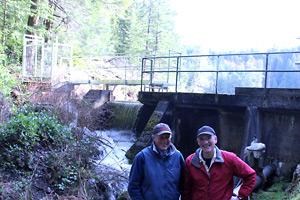Powell River Regional District rural directors have turned down a request to advance funds to the Lund Waterworks Improvement District for upgrades to its water system.
A report that provided options for projects funded by community works funding, which is revenue the regional district receives from the federal government through a transfer of the gas tax, was part of the rural services committee meeting agenda on March 21. The options included $156,169 for the Lund system. The total included $33,169 for a mandatory dam safety review, $87,000 for an upgrade to the Larson Road booster station and $115,000 for an upgrade to the main pump house.
Patrick Brabazon, Area A director, attempted to make a motion to provide the funds, but no one seconded his motion.
Dave Murphy, Texada Island director, pointed out that other improvement districts, notably the two on Texada, were also strapped for funds. “I don’t want to pick one and say, you’re the ones who are the lucky ones and here’s the money,” he said. “We have to look at something regional.”
Al Radke, regional district chief administrative officer, said he believes that eventually the provincial government will require regional districts to take over responsibility of water systems that can’t meet provincial requirements. “This is bigger than all of us, because water is the sustenance of life,” he said. “I think we have to brace ourselves for the fact, whether it was provincial error in the past to allow improvement districts to create their own water systems, whatever is going to happen, the cleanup is going to end up on our doorstep.”
The regional district has an unwritten policy that it will consider taking over independent water systems, if they meet provincial standards. The Lund improvement district requested the regional district take over the water system in 2004. That led to an engineering study that found it would cost about $6 million to bring the system up to current provincial standards. The regional district applied for federal-provincial government infrastructure funding for the project, but the grant application was unsuccessful.
Harry Robertson is chair of the Lund improvement district, which has about 110 connections, most residential but some commercial. It costs users $500 a year for water, which comes from Lund Lake, then flows into Thulin Lake, where the intake is located.
The system has had a boil water advisory in place for a few weeks, Robertson said, due to a problem with the chlorinator. “We test the water at the extremities for the amount of chlorine in the system and the tests were coming up with little to no chlorine,” he said. While the problem is solved, he added, there have to be clear tests for three consecutive weeks before the advisory can be lifted.
The organization has between $30,000 to $35,000 a year to put toward capital projects, Robertson explained. “We have been diligently putting that money toward improving our infrastructure, because a lot of it is old and was put in by a dedicated group of volunteers,” he said. “We have an aging, failing infrastructure.”
Vancouver Coastal Health has requirements for all water systems and the Lund system has to be upgraded to meet those requirements. The first priority is to bring the pumping system and chlorinator up to speed, Robertson said.
Volunteers who have worked on the system over the years are also becoming older and some are stepping away. The improvement district should hire someone to operate the system, Robertson said, but there is no money to do that.
Adding to the financial challenges is a requirement by the provincial government for a dam safety review by qualified engineers. The Lund system has two dams and the study cost $35,000. It included a list of recommendations to prepare for an event, like an earthquake, that could happen in the next 2,500 years and potentially damage the dams.
Improvement districts don’t qualify for federal-provincial government infrastructure grants, however, so there is no funding available for the costly upgrades that the province requires. “It’s just a huge problem,” Robertson said. “We’re caught between a rock and a financial hard place.”
Meanwhile, the rural services committee passed a motion directing staff to report on the issue of regional water systems at the next rural services committee meeting.



